April 2025

The global in vitro lung model market size was estimated at US$ 312 million in 2023 and is projected to grow to US$ 1,653.59 million by 2034, rising at a compound annual growth rate (CAGR) of 17.7% from 2024 to 2034. The market is growing due to research and development related to lung and lung-related disorders. Invitro lung model reduces the use of animal models and provides better results. Key market players are heavily invested in developing new therapeutics using the Invitro lung model.
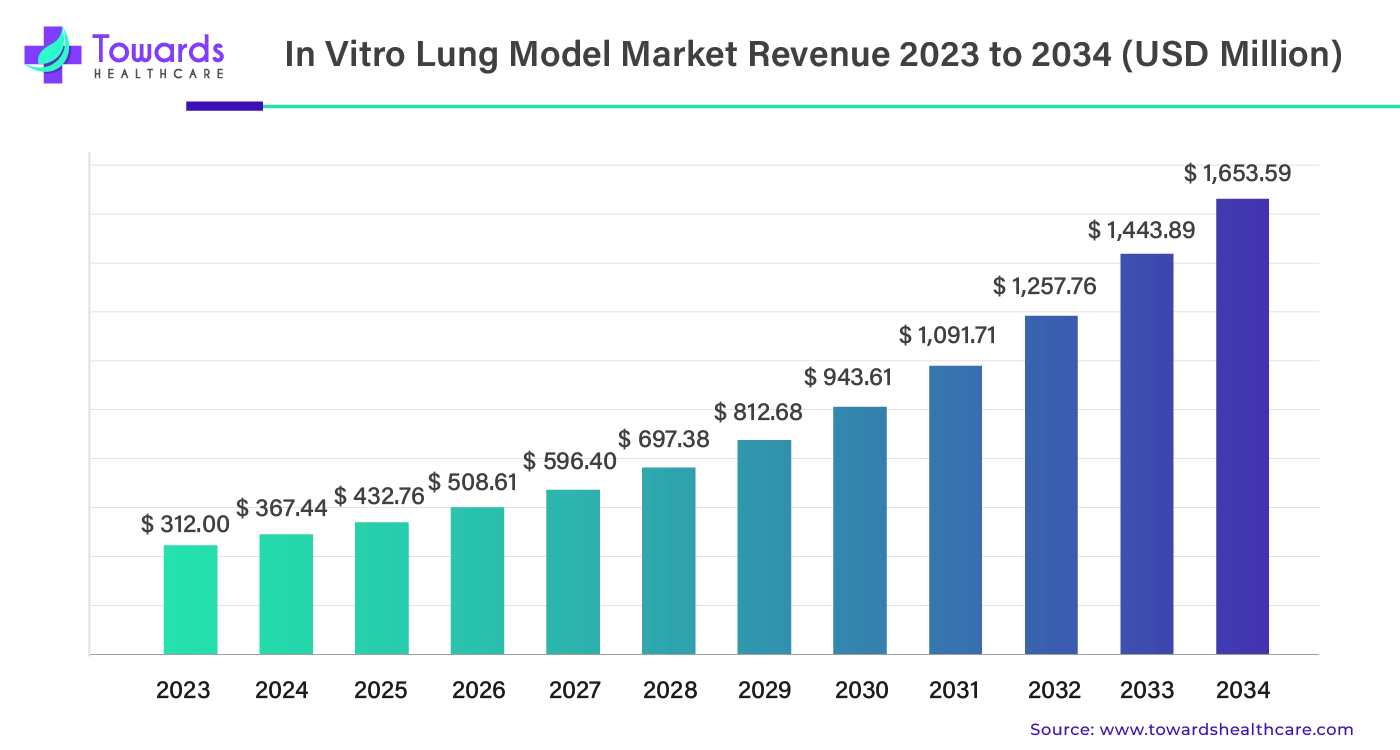
An in vitro lung model is a two- or three-dimensional culture of cells that is generated in a lab to mimic the functionality of real lungs and lung cells. For research on lung pathology (including infections, inflammations, cancers, and small-airway pulmonary illnesses), medication delivery, and toxicity, both in vivo and in vitro models are utilized. The evaluation of medication deposition efficiency and the investigation of the effects of inhaled chemicals and nanomaterials on the lungs and peripheral tissue both benefit from the use of in vivo models. Creating lung models is becoming more and more necessary as COPD becomes more common.
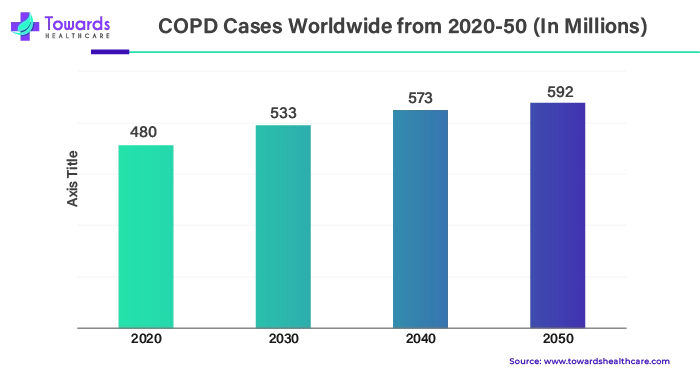
Utilizing automation and artificial intelligence (AI) may enhance cell culture at every step, leading to more productive drug development and research as well as faster, smarter decision-making. In order to ensure correct growth and prevent injury or aspiration during feeding, 3D cell cultures may be maintained and observed continuously with the help of automation and artificial intelligence (AI). Techniques for 3D model scaling that ensure consistency and repeatability might be made easier with the help of AI. By employing AI-driven automation and decision-making, researchers may either choose a co-piloted strategy or fully autonomous cell culture processes. Apart from standardizing procedures, this encourages consistency and reproducibility across 2D and 3D cell culture processes.
For instance,
| Company Name | POSTECH |
| Headquarters | South Korea, Asia Pacific |
| Recent Development | In August 2024, the Infectious Diseases Therapeutic Research Center of the Korea Research Institute of Chemical Technology (KRICT) partnered with the research team from the Department of Materials Science and Engineering at Pohang University of Science and Technology (POSTECH) to successfully create artificial lungs. These prosthetic lungs are intended for research on infections and medication testing related to respiratory illnesses, such as COVID-19. In addition to contributing to the development of therapeutic medications for COVID-19 and other respiratory illnesses, this research will significantly accelerate the drug development process. |
| Company Name | IISc |
| Headquarters | India, Asia Pacific |
| Recent Development | In June 2024, a unique three-dimensional hydrogel culture system that replicates the environment of a mammalian lung was created by researchers at the Indian Institute of Science (IISc), Department of Bioengineering (BE). It offers an effective way to monitor and investigate the process by which tuberculosis bacteria infect lung cells and evaluate the effectiveness of treatments for tuberculosis. |
One of the leading causes of illness and death in the globe is infectious diseases. The identification of infectious diseases is crucial to surgical pathology because of the constant emergence of new pathogens, the resurgence of known infectious diseases, the rise in microbial resistance to antibiotics, changes in the global environment, the ease of international travel, and the rise in the number of people with compromised immune systems. Lung organoids and bioengineered organs-on-chips, two examples of three-dimensional (3D) cell cultures, are becoming more important research instruments for respiratory illnesses. Studies on the lung's response to infection by different pathogens, such as influenza A and coronavirus, have been effectively conducted using the lung airway, small airway, and alveolus organ chips.
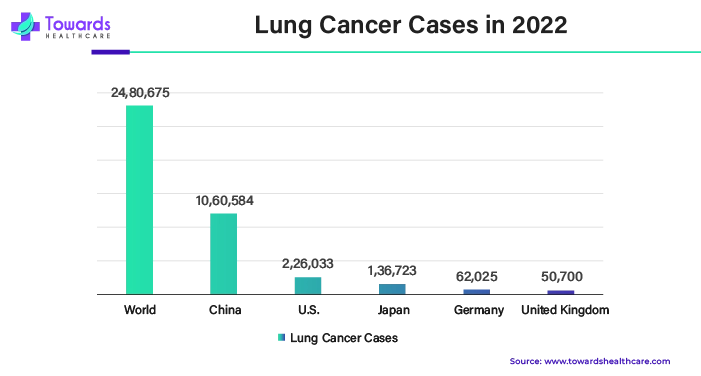
The prevalence of cancer is growing due to factors like smoking and air pollution. As the prevalence of cancer is increasing, the demand for cancer therapeutics is increasing. Researchers are continuously making efforts in R&D. The new therapeutics that are developed need pre-clinical studies, which are usually conducted on animal models. However, animal models cannot provide accurate results, which is why the use of in vitro lung models is more useful and accurate. In recent years, 2D and 3D models have been developed to mimic the same cell structure and environment found in in-vivo lungs.
The use of 2D and 3D cell culture is a relatively new field. Compared to 2D models, 3D models are even more complex to maintain and study. Using 3D models requires both theoretical and practical knowledge. There is a lack of professionals who are experts in 3D models. When it comes to developing and underdeveloped countries, they lack trained professionals and resources to train them. It is going to take time to provide resources and training to researchers in such countries. Governments can collaborate to help lower economic countries. Companies can establish their benches in these countries to increase the market’s growth.
By type, the 2D model segment held the largest share of the in vitro lung model market in 2023. Culture cells in the laboratory provide a better understating of cell biology, mechanisms of disease, tissue morphology, drug action, and other functions. 2D cell cultures are easy to grow and maintain. Therefore, a lot of studies have been conducted on 2D cell cultures. 2D cell cultures are grown on a flat surface, which requires fewer reagents and fewer surfaces. 2D cell culture can be maintained and produced at a low cost, which reduces the overall cost of conducting experiments. 2D cell culture can be used to test new drugs and therapeutics.
Personalized medicines are the new age of healthcare in which medicines and therapeutics are designed specifically for a person based on their genetic material, lifestyle, environment, occupation, and any other factor that can impact the impact of therapeutics. As the 2D and 3D models are developed using human cells, patients' human cells can be used to develop in vitro lung models for producing personalized medicines/therapeutics. Based on the research conducted on individual people, the therapeutics and drugs can be manipulated and adjusted to individual needs, which will lead to higher quality of care and better outcomes. It will not only reduce hospital admissions, but it will also improve the quality of life.
For instance,
By type, the 3D model segment is anticipated to grow at the fastest rate in the in vitro lung model market during the forecast period. When it comes to 3D models, the cells are grown in a 3-dimensional structure. 3D models have several advantages over 2D models, which is why the use of 3D models is growing in research and development. 3D models are able to mimic similar environments to actual organs. Due to this, the study associated with drugs and therapeutics provides more accurate results than animal models and 2D models. In the future, with technological advancements and better resources, researchers will also be able to develop exact replicas of actual organs that could be used in organ transplantation.
By application, the drug discovery & toxicology studies segment dominated the in vitro lung model market in 2023. The study of toxins and drugs goes through various stages. The final stage of the study is conducting clinical trials in which people are used as volunteers to do the final study before launching the product in the market. Before clinical trials, the drugs and toxins are tested on animal models to analyze the effects, impact, and side effects. When it comes to using models, the 2D and 3D models provide better and more accurate results because human cells are used for testing. In the case of chronic lung diseases, respiratory disorders, and lung cancer, the in vitro lung model is highly useful.
By application, the 3D model development segment is expected to be the fastest-growing segment in the in vitro lung model market during the predicted period. The 3D models of lungs are developed for various reasons. First of all, it is able to mimic the in-vivo environment of the lungs, due to which the results of the functioning of lungs, study of drugs and toxins, and other research are more closely related to how it will occur in the actual human body. As tumors are 3-dimensional, studying their function and therapeutics will not be very suitable when using 2D models. In the future, if researchers are able to make an exact replica of the actual organ or part of an organ, then transplantation will become much easier than now.
By end-use, the pharmaceutical & biotechnology companies segment held the dominant share of the in vitro lung model market in 2023. Both pharmaceutical and biotechnology companies are highly invested in conducting research. This research can be associated with studying diseases, development of new drugs and therapeutics, studying genetics, studying, and so on. These companies invest in the studies on an individual level, and they collaborate with each other to provide financial and resource support. With lung cancer and COPD being the top causes of death, these companies will use in vitro lung models to develop new drugs and therapeutics to cure the diseases.
By end-use, the academic & research institutes segment is estimated to grow at the fastest CAGR in the in vitro lung model market during 2024-2034. Research institutions support new searches and studies conducted by students and professors. These institutions provide pioneer and unique studies that create pillars for advancements in medical and healthcare research. Academic research institutes provide funding and resources to students to conduct their research.
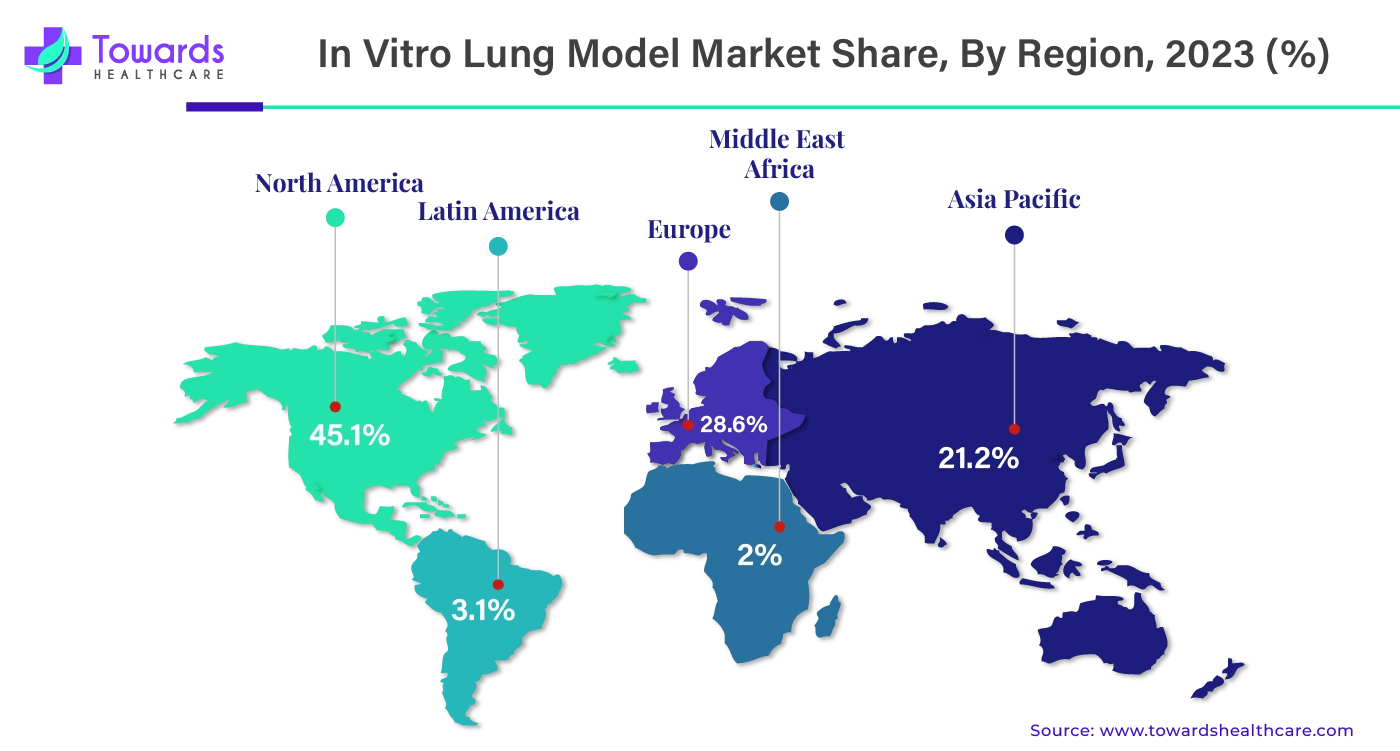
North America dominated the in vitro lung model market share by 45.1% in 2023. North America is leading due to advanced healthcare infrastructure, the presence of key market players, growing innovation, government investment, and so on. Apart from better resources, the growing prevalence of lung cancer cases along with respiratory diseases is driving the in vitro lung model market. The growing prevalence of the disease is pushing companies and governments in North America to take steps to invest more in research and development. The top countries that promote North America’s growth are the U.S. and Canada. It is estimated that over the next 20 years, COPD expenditures in the U.S. would rise to around $40 billion annually, or $800 billion, over the course of the project.
Asia Pacific is expected to grow at a significant rate during the forecast period. Asia Pacific’s in vitro lung model market is growing due to the growing population, which provides several advantages. China, India, Japan, and South Korea are the major countries that are contributing to the growth of the market. China is the technological hub, and India, being the growing economy, is the major contributor.
When it comes to lung cancer, China ranked number 1 in 2022, according to the World Cancer Research Fund International. Japan and India rank 3rd and 4th in lung cancer cases respectively. This is promoting the growing cancer research in the Asia Pacific, which will use an in vitro lung model.
Apart from lung cancer, the cases of respiratory disorders are also growing in Asia Pacific. Due to this, governments are investing heavily in conducting research. When it comes to China, around 100 million people are living with COPD, which is equivalent to 25% of all the cases of COPD cases worldwide. To overcome the challenge of COPD, China developed a medium-to-long-term plan (2017-2025). The study's outcome has been the distribution of 30,000 portable spirometry equipment units, which covers more than half of the nation's primary care institutions. In order to improve their capacity to detect COPD in its early stages, almost 140,000 primary healthcare practitioners received extensive training in pulmonary function tests between 2020 and 2023.
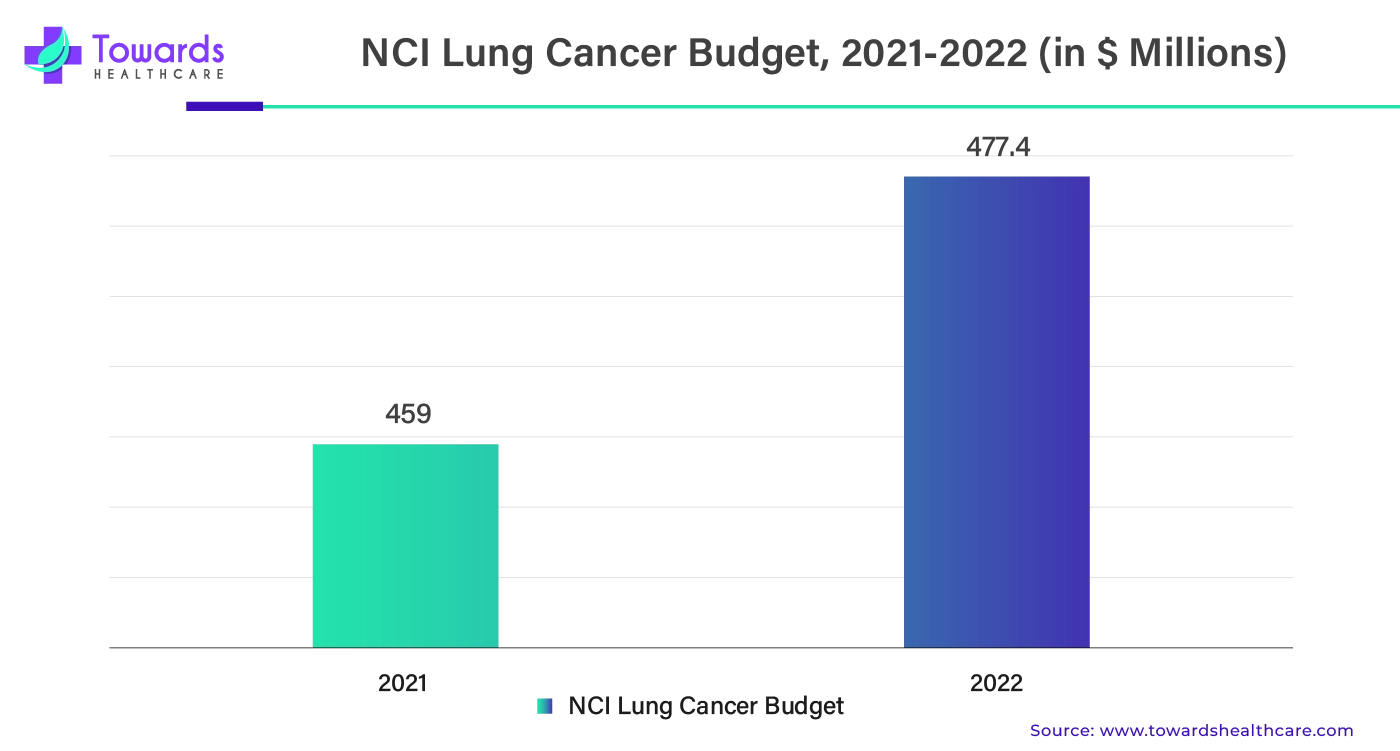
By Type
By Application
By End-use
By Region
April 2025
April 2025
April 2025
April 2025